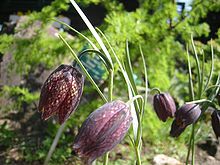Fritillaria
| Fritillaria | |
|---|---|
 |
|
| Fritillaria montana | |
| Scientific classification | |
| Kingdom: | Plantae |
| (unranked): | Angiosperms |
| (unranked): | Monocots |
| Order: | Liliales |
| Family: | Liliaceae |
| Subfamily: | Lilioideae |
| Tribe: | Lilieae |
| Genus: |
Fritillaria L. |
| Synonyms | |
|
Synonymy
|
|
Fritillaria is a genus of Eurasian, North African, and North American plants in the lily family.
There are about 100 to 130species of bulbous plants in the family Liliaceae, native to temperate regions of the Northern Hemisphere, especially the Mediterranean, southwest Asia, and western North America. The name is derived from the Latin term for a dice-box (fritillus), and probably refers to the checkered pattern of the flowers of many species. Plants of the genus are known in English as fritillaries. Some North American species are called mission bells.
Fritillaries often have nodding, bell- or cup-shaped flowers, and the majority are spring-flowering. Certain species have flowers that emit disagreeable odors. The scent of Fritillaria imperialis has been called "rather nasty", while that of F. agrestis, known commonly as stink bells, is reminiscent of dog droppings. On the other hand, F. striata has a sweet fragrance.
Fritillaria extracts are used in traditional Chinese medicine under the name chuan bei mu, and in Latin, bulbus fritillariae cirrhosae. Species such as F. cirrhosa and F. verticillata are used in cough remedies. They are listed as chuān bèi (Chinese: 川貝/川贝) or zhè bèi (Chinese: 浙貝/浙贝), respectively, and are often in formulations combined with extracts of loquat (Eriobotrya japonica). Fritillaria verticillata bulbs are also traded as bèi mǔ or, in Kampō, baimo (Chinese/Kanji: 貝母, Katakana: バイモ). In one study fritillaria reduced airway inflammation by suppressing cytokines, histamines, and other compounds of inflammatory response.
...
Wikipedia
